小学二年级英语:Going about ---- 公开课教案
Going about ---- 公开课教案
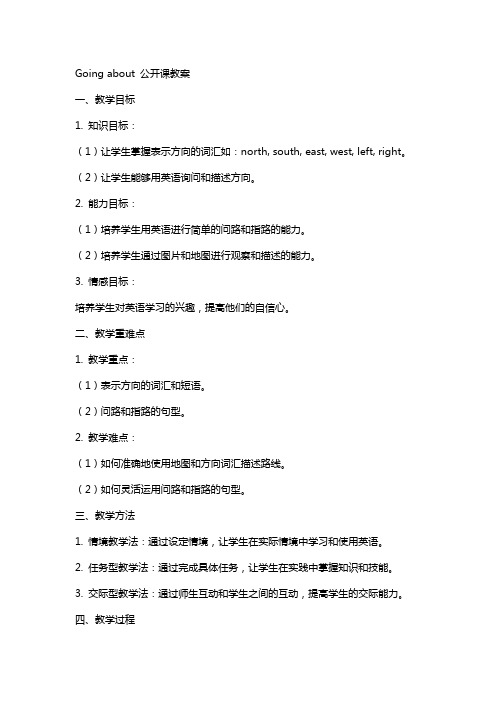
Going about 公开课教案一、教学目标1. 知识目标:(1)让学生掌握表示方向的词汇如:north, south, east, west, left, right。
(2)让学生能够用英语询问和描述方向。
2. 能力目标:(1)培养学生用英语进行简单的问路和指路的能力。
(2)培养学生通过图片和地图进行观察和描述的能力。
3. 情感目标:培养学生对英语学习的兴趣,提高他们的自信心。
二、教学重难点1. 教学重点:(1)表示方向的词汇和短语。
(2)问路和指路的句型。
2. 教学难点:(1)如何准确地使用地图和方向词汇描述路线。
(2)如何灵活运用问路和指路的句型。
三、教学方法1. 情境教学法:通过设定情境,让学生在实际情境中学习和使用英语。
2. 任务型教学法:通过完成具体任务,让学生在实践中掌握知识和技能。
3. 交际型教学法:通过师生互动和学生之间的互动,提高学生的交际能力。
四、教学过程1. 课堂导入(5分钟)(1)教师展示一张地图,引导学生关注地图上的方向标识。
(2)教师用英语介绍地图上的主要道路和建筑。
2. 新课呈现(15分钟)(1)教师展示图片,引导学生用英语描述图片中的方向。
(2)教师教授表示方向的词汇和短语,如:north, south, east, west, left, right。
(3)教师创设情境,让学生用英语询问和描述方向。
3. 课堂活动(15分钟)(1)学生分组,每组制作一张简单的地图。
(2)学生用英语描述地图上的路线和方向。
(3)学生展示自己的地图,并用英语解释。
4. 巩固练习(5分钟)(1)教师设计一些问路和指路的练习题。
(2)学生独立完成练习,教师给予反馈。
五、课后作业1. 学生回家后,绘制一张家庭附近的地图。
2. 学生用英语描述地图上的路线和方向,并家庭成员分享。
教学反思:本节课通过情境教学法、任务型教学法和交际型教学法,让学生在实际情境中学习和使用英语。
在教学过程中,教师应关注学生的个体差异,给予每个学生充分的参与和表达机会。
Going about 公开课教案
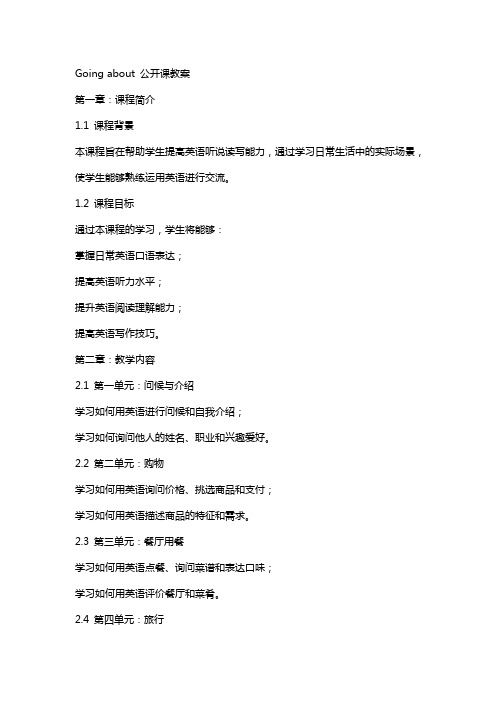
Going about 公开课教案第一章:课程简介1.1 课程背景本课程旨在帮助学生提高英语听说读写能力,通过学习日常生活中的实际场景,使学生能够熟练运用英语进行交流。
1.2 课程目标通过本课程的学习,学生将能够:掌握日常英语口语表达;提高英语听力水平;提升英语阅读理解能力;提高英语写作技巧。
第二章:教学内容2.1 第一单元:问候与介绍学习如何用英语进行问候和自我介绍;学习如何询问他人的姓名、职业和兴趣爱好。
2.2 第二单元:购物学习如何用英语询问价格、挑选商品和支付;学习如何用英语描述商品的特征和需求。
2.3 第三单元:餐厅用餐学习如何用英语点餐、询问菜谱和表达口味;学习如何用英语评价餐厅和菜肴。
2.4 第四单元:旅行学习如何用英语询问交通方式、预订酒店和描述景点;学习如何用英语表达旅行计划和需求。
2.5 第五单元:健康与医疗学习如何用英语描述身体状况和疾病症状;学习如何用英语询问医生建议和药物用法。
第三章:教学方法3.1 任务型教学法:通过设定真实的语言环境,让学生在完成任务的过程中学习和使用英语。
3.2 情景教学法:通过模拟生活场景,让学生在实际语境中学习和应用英语。
3.3 互动教学法:通过教师与学生、学生与学生之间的互动,激发学生的学习兴趣和积极性。
第四章:教学评价4.1 课堂参与度:观察学生在课堂活动中的参与程度,了解学生的学习积极性。
4.2 口语表达:评估学生在实际场景中运用英语进行口语表达的能力。
4.3 听力测试:通过听力练习,测试学生的英语听力水平。
4.4 作业与测验:定期布置作业和进行测验,了解学生的学习进度和掌握程度。
第五章:教学资源5.1 教材:选用适合学生水平的英语教材,提供丰富的学习内容。
5.2 多媒体教学:利用多媒体课件、视频和音频等资源,增加课堂的趣味性和互动性。
5.3 网络资源:利用网络平台,提供在线学习资源和互动交流的机会。
第六章:教学活动设计6.1 热身活动:通过简单的英语歌曲、游戏或话题讨论,让学生放松气氛,激发学习兴趣。
二年级英语上册 Unit4 Going about教案 沪教版
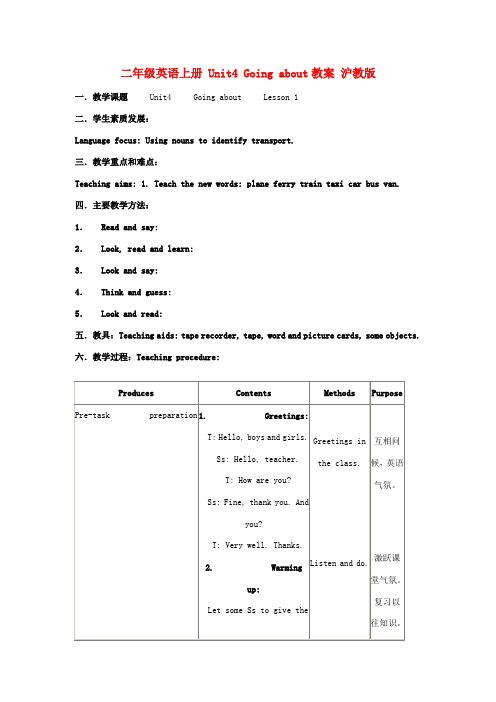
二年级英语上册 Unit4 Going about教案沪教版一.教学课题Unit4 Going about Lesson 1二.学生素质发展:Language focus: Using nouns to identify transport.三.教学重点和难点:Teaching aims: 1. Teach the new words: plane ferry train taxi car bus van.四.主要教学方法:1. Read and say:2. Look, read and learn:3. Look and say:4. Think and guess:5. Look and read:五.教具:Teaching aids: tape recorder, tape, word and picture cards, some objects.六.教学过程:Teaching procedure:板书:通过唱歌的形式,学生掌握良好,但对个别单词plane, ferry 的读音和play very容易搞混。
一.教学课题Unit4 Going about Lesson 2二.学生素质发展:Language focus: Asking How questions to find out means.e.g. How do you go to the park ?Using prepositions to indicate meanse.g. I go to the park by bus/taxi.Using formulaic expressions to take leave.三.教学重点和难点:Teaching aims: 1. Teach the new instructions: How do you go to the park ?I go to the park by bus/taxi.四.主要教学方法:1. Read and say:2. Look, read and learn:3. Look and say:4. Think and guess:5. Look and read:五.教具:Teaching aids: tape recorder, tape, word and picture cards, some objects.六.教学过程:Teaching procedure:板书:一.教学课题Unit4 Going about Lesson 3二.学生素质发展:Language focus: Using imperatives to give simple instruction.e.g. Get in the car.三.教学重点和难点:Teaching aims: 1. Teach the new instructions: Get in the car.Get off the car.四.主要教学方法:1. Read and say:2. Look, read and learn:3. Look and say:4. Think and guess:5. Look and read:五.教具:Teaching aids: tape recorder, tape, word and picture cards, some objects.六.教学过程:Teaching procedure:板书:教学后记:由于口令较为,所以学生掌握情况良好。
二年级英语上册 Unit 4 Going about(period4)教案
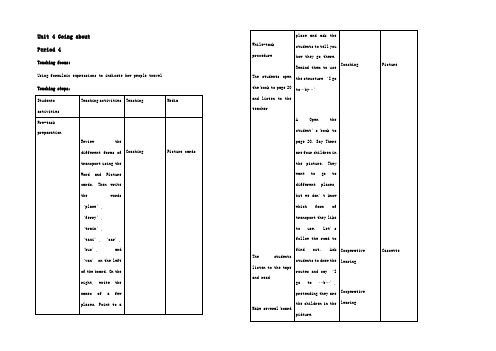
Coaching
Cooperative learing
Cooperative learing
Coaching
coaching
Picture cards
Picture
Cassette
workbook
A Open the student’s book to page 20. Say There are four children in the picture. They want to go to different places, but we don’t know which form of transport they like to use. Let’s follow the road to find out. Ask students to draw the routes and say‘I go to…b…’, pretending they are the children in the pidture.
Make several boardgames that can be used in small groups to revise the expression’I go to…by…’and the vocabulary they have learned.
Post-task activity
The students answer the teacher’s question
Unit 4 Going about
Period 4
Teachingfocus:
Using formulaic expressions to indicate how people travel
Teaching steps:
二年级英语上册Unit4Goingaboutperiod5教案
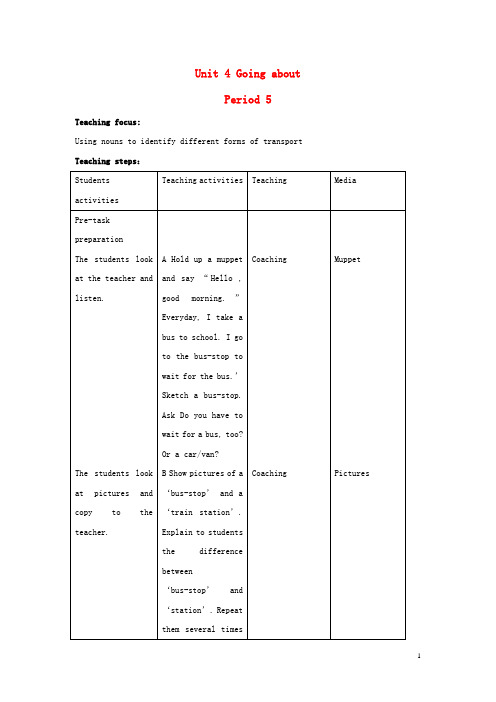
B Show pictures of a ‘bus-stop’ and a ‘train station’. Explain to students the difference between ‘bus-stop’ and ‘station’. Repeat them several times and let students copy you.
E Invite students to sing along with the tape. Encourage them to imitate the sound of each type of transport
Ask groups of students to mime each part of the song in front of the class while the tape is being played. Students can take different role. Let students say what type of transport they are drivin by line for students to follow until they are familiar with the words. Then go through the second and third verse in the same way.
二年级英语上册 Unit 4 Going about(period1)教案
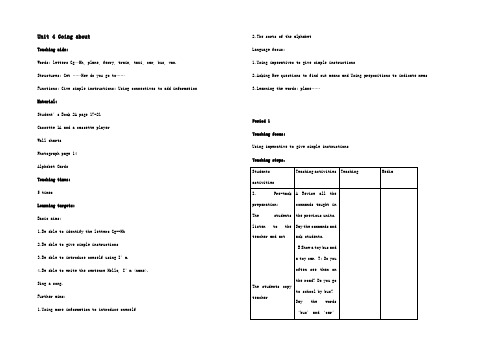
Teach the other two commands to do with cars and buses;
2.AskingHow questions to find outmeansand Usingprepositionsto indicate meas
3.Learning the words: plane……
Period 1
Teachingfocus:
Usingimperativeto give simple instructions
Say the words‘bus’and‘car’clearly.
A Put two chairs in a line. Ask student to sit in the front chair and act as a car driver. Pretend to get in the car by bending over and sitting in the back chair. T: Get in the car. Practise with more students.
II. While-task procedure:
Practise with more students.
The students act
Asmallgroup of students line up in front as if theyare ready to get off the bus.
Repeat
Get out of the car.
沪教版英语二年级上册《Goingabout》教案_二年级英语教案上册

沪教版英语二年级上册《Going about》教案教学目标•能够听懂、说出四个月份的英文单词并正确运用,如 January, February, March, April。
•能够运用一些基本的问候语,如 How are you? Fine, thank you. And you?。
•能够较流利地说出代表某种交通工具的英文单词,并了解其用途,如car, bike, bus, subway。
•能够运用所学内容,进行短对话,如问路、提供帮助等。
•能够对所学内容进行口头或书面的复述。
教学内容月份•教师出示包括 January, February, March, April 的图片到教室,教师用英文读出月份,然后叫学生模仿自己的读音。
同时,教师提醒学生这是一年中的前四个月。
•教师展示月份名字的拼写,然后带领学生进行阅读。
•与学生进行多次口头练习,使学生对月份的拼写和发音更为熟悉。
问候语•教师先用频率较高的 How are you? Fine, thank you. And you? 进行讲解。
教师模仿这一问答,让学生跟着模仿,说出问候语。
•通过与同伴交流,让学生更多地应用问候语。
交通工具•教师出示包括 car, bike, bus 和 subway 的图片,读出单词,让学生跟着模仿,同时让学生了解不同交通工具的用途、如何乘坐和它们的特点。
•学生通过阅读教材和教师的讲解,学习如何描述和区分不同交通工具。
问路•学生通过小组讨论,模拟在陌生环境下如何向别人问路,并听取别人的建议,进行口语表达练习。
•教师提供简单的方位名词,并教授如何表述方向,如 left, right, straight ahead, turn around。
•学生通过小组讨论,模拟在陌生环境下如何向别人问路,并听取别人的建议,进行口语表达练习。
教学方法•教师引导学生以“听-说-读-写”的四个环节进行探究学习。
•教师采用多种形式进行教学,如教师讲解、学生讨论和合作活动等。
二年级英语教学研讨 Unit-4-Going-about-教学设计
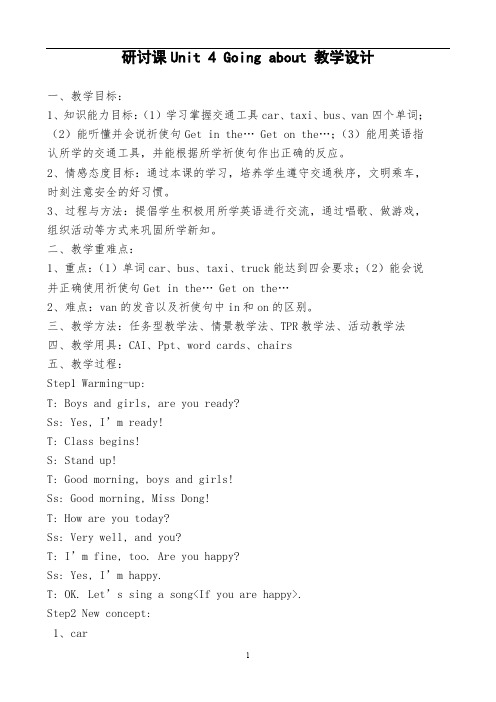
研讨课Unit 4 Going about 教学设计一、教学目标:1、知识能力目标:(1)学习掌握交通工具car、taxi、bus、van四个单词;(2)能听懂并会说祈使句Get in the… Get on the…;(3)能用英语指认所学的交通工具,并能根据所学祈使句作出正确的反应。
2、情感态度目标:通过本课的学习,培养学生遵守交通秩序,文明乘车,时刻注意安全的好习惯。
3、过程与方法:提倡学生积极用所学英语进行交流,通过唱歌、做游戏,组织活动等方式来巩固所学新知。
二、教学重难点:1、重点:(1)单词car、bus、taxi、truck能达到四会要求;(2)能会说并正确使用祈使句Get in the… Get on the…2、难点:van的发音以及祈使句中in和on的区别。
三、教学方法:任务型教学法、情景教学法、TPR教学法、活动教学法四、教学用具:CAI、Ppt、word cards、chairs五、教学过程:Step1 Warming-up:T: Boys and girls, are you ready?Ss: Yes, I’m ready!T: Class begins!S: Stand up!T: Good morning, boys and girls!Ss: Good morning, Miss Dong!T: How are you today?Ss: Very well, and you?T: I’m fine, too. Are you happy?Ss: Yes, I’m happy.T: OK. Let’s sing a song<If you are happy>.Step2 New concept:1、carT: Today I’m very happy, because yesterday is my birthday, and my friend Miss Wang gave me a present. And today I take it here, do you want to see?Ss: Yes.T: Guess, what’s this?Ss: It’s a car.T: Yes. It’s a toy car. (领读两遍,然后幻灯片出示car) This is a car. Let’s spell it together: c-a-r, car.(boys say; girls say. And then one by one)What am I doing?Ss: 开车。
Going about ---- 公开课教案
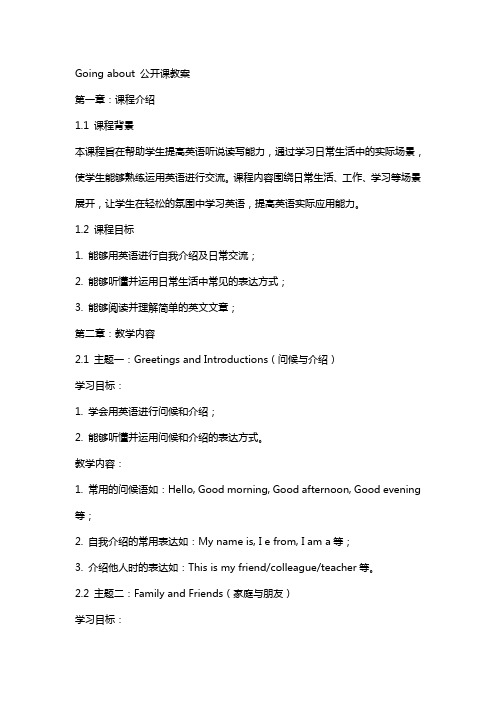
Going about 公开课教案第一章:课程介绍1.1 课程背景本课程旨在帮助学生提高英语听说读写能力,通过学习日常生活中的实际场景,使学生能够熟练运用英语进行交流。
课程内容围绕日常生活、工作、学习等场景展开,让学生在轻松的氛围中学习英语,提高英语实际应用能力。
1.2 课程目标1. 能够用英语进行自我介绍及日常交流;2. 能够听懂并运用日常生活中常见的表达方式;3. 能够阅读并理解简单的英文文章;第二章:教学内容2.1 主题一:Greetings and Introductions(问候与介绍)学习目标:1. 学会用英语进行问候和介绍;2. 能够听懂并运用问候和介绍的表达方式。
教学内容:1. 常用的问候语如:Hello, Good morning, Good afternoon, Good evening 等;2. 自我介绍的常用表达如:My name is, I e from, I am a等;3. 介绍他人时的表达如:This is my friend/colleague/teacher等。
2.2 主题二:Family and Friends(家庭与朋友)学习目标:1. 学会用英语介绍家庭成员和朋友;2. 能够听懂并运用家庭和朋友相关的表达方式。
教学内容:1. 家庭成员的英语表达如:mother, father, sister, brother等;2. 朋友的英语表达如:friend, colleague, neighbor等;3. 介绍家庭成员和朋友时的常用表达如:My mother is a teacher, My friend likes music等。
第三章:教学方法3.1 任务型教学法:通过完成各种实际任务,提高学生的英语应用能力;3.2 情景教学法:创设真实的场景,让学生在实际情境中学习英语;3.3 互动式教学法:鼓励学生积极参与课堂活动,提高课堂氛围。
第四章:教学评价4.1 平时作业:检查学生对课程内容的理解和掌握程度;4.2 课堂表现:评估学生在课堂上的积极参与度和表现;4.3 期末考试:测试学生的英语听说读写能力。
(二年级英语教案)Goingabout教案
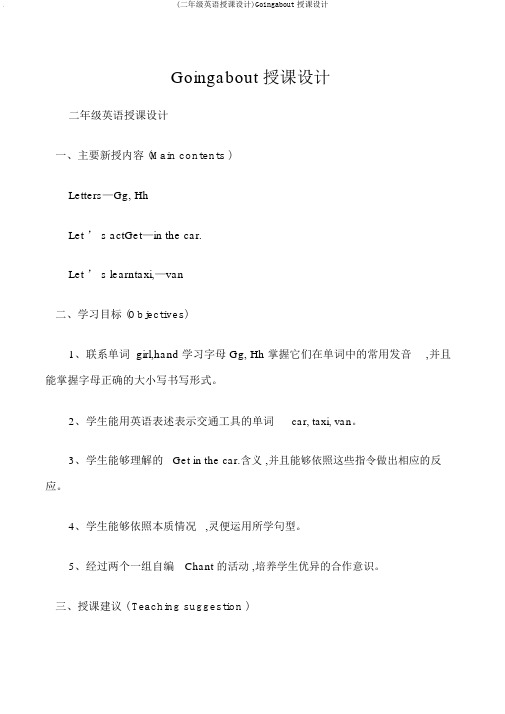
(二年级英语授课设计)Goingabout授课设计
Goingabout 授课设计
二年级英语授课设计
一、主要新授内容 (Main contents )
Letters—Gg, Hh
Let ’ s actGet—in the car.
Let ’ s learntaxi,—van
二、学习目标 (Objectives)
1、联系单词 girl,hand 学习字母 Gg, Hh 掌握它们在单词中的常用发音,并且能掌握字母正确的大小写书写形式。
2、学生能用英语表述表示交通工具的单词car, taxi, van。
3、学生能够理解的Get in the car.含义 ,并且能够依照这些指令做出相应的反应。
4、学生能够依照本质情况,灵便运用所学句型。
5、经过两个一组自编Chant 的活动 ,培养学生优异的合作意识。
三、授课建议 ( Teaching suggestion )。
- 1、下载文档前请自行甄别文档内容的完整性,平台不提供额外的编辑、内容补充、找答案等附加服务。
- 2、"仅部分预览"的文档,不可在线预览部分如存在完整性等问题,可反馈申请退款(可完整预览的文档不适用该条件!)。
- 3、如文档侵犯您的权益,请联系客服反馈,我们会尽快为您处理(人工客服工作时间:9:00-18:30)。
新修订小学阶段原创精品配套教材Going about ---- 公开课教案教材定制 / 提高课堂效率 /内容可修改
Going about ---- Open lesson plan
教师:风老师
风顺第二小学
编订:FoonShion教育
Going about ---- 公开课教案
teaching plan1
teacher: yu hai jiao class 3, grade 1 december 9, 2008
title: going about
textbook: oxford english ----- 1a
teaching
aims
contents& abilities
1.ss can use nouns to identify forms of transport: plane, ferry, train, taxi, van.
asking how questions to find out means.
using prepositions to indicate means.
improving students listening and speaking abilities.
process& methods
direct teaching approach ;
communicative teaching approach
and tpr(total physical response)
moral education
1.making the students feel happy
2.cooperative consciousness
key points
1. five new words : plane, ferry, train, taxi, van
2. sentence patterns:
how do you go to the park?
i/ we go to the park by….
3.developing expressing ability
difficult points
ing the words and sentences in a certain time and certain time.
2. using preposition” by” to indicate means.
teaching method
tblt
teaching aids
multi-media, pictures recorder& tape
teaching procedures
i warming-up & revision:
1. i like chicken. yummy, yummy…
2. hello/good morning/how are you?/what do you like?
where do you live?
ii leading-in: using a paper plane to lead in the new lesson.
today we will go on to learn unit4 going about.
iii presentation:
learn 5 new words .
show them a picture of a plane.
1. plane a. meaning
b. pronunciation
c. spell the word using figures
d. reading (team by team ) .(high &low voice )
e. make a sentence using” plane”.
f. using ‘pictures ’to lead to next word
show the picture of shanghai. and ask the students the question:” how do you go to shanghai?”
new sentence: how do you go to shanghai?(read with action)
i go to shanghai by plane/ ferry/ train…
2. ferry a. meaning
b. pronunciation
c. making up sentences by using ‘ferry’
d. use the sound of train to lead to next word.
3.train a. meaning
b. pronunciation
c. spell the word using figures
d. reading
4.taxi a. meaning
b. pronunciation
c. spell the word using figures
d. reading (reading with actions )
5.van a. meaning
b. reading (reading with action )
c. making up new sentences .
show a picture of a park. ask students the question:” how do you go to the park?” then bring in the answer:” i go to the park by taxi/ car/bus/van…”
iv
drills & practice :
1. listen to the tape & follow the tape: page 34 & 35.
2. pair-work: i go to …by…
two students to make up a dialogue
3. group work: two students want to go to shanghai. two students want to go to the park. one day, they meet on the road and make a dialogue.
students’
activity
students recite the rhyme and answer my questions.
students read the words several times.
students read the sentence after me part by part. students listen to the sound and guess the word. students make sentences using van, car, taxi, bus…. four students a group do the dialogue.
aims
review the old knowledge.
solid the new words.
use the picture of shanghai to teach the new sentence. use the sound of the train to lead in the new word. solid the new words and the new sentences.
use the pair work and the group practise the dialogue
FoonShion教育研究中心编制
Prepared by foonshion Education Research Center。
